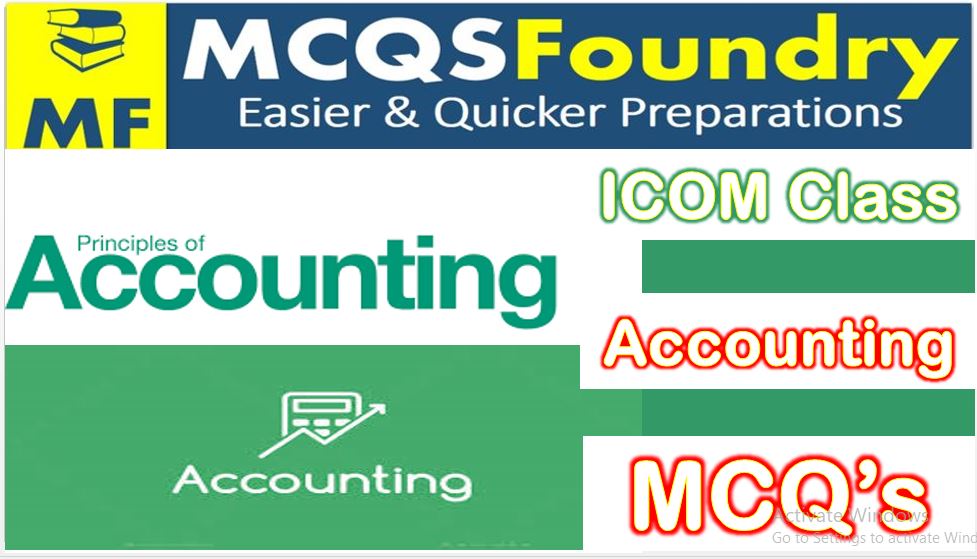MCQsFoundry.com brings to you 500+ Financial Accounting ICOM Mcqs which are new and latest. These Mcqs are never published on internet so far. For full information about all PPSC / FPSC / CSS / PMS latest jobs visit theiteducation.com

Chapter – 1
INTRODUCTION
Encircle the most appropriate answer from following:
1)The prime function of accounting is to:
- Record economic data
- Classifying and summarising business transactions
- Classifying and recording business transactions
- Provide the information basis for action
2) Any legal activity which is done for the purpose of earning profit, is called :
- Business
- Trust
- Society
- None of a & b
3) All those thing, which are purchased for resale purpose, are called:
- Assets
- Liabilities
- Sale
- Goods
4) Book-keeping is mainly concerned with:
- Classifying of business transactions
- Interpreting of business transactions in money terms.
- None of above
- Recording of business transactions
5) Book-keeping provides the:
- Final information
- Primary function
- Secondary function
- All of the above
6) how many branches of accounting are:
- Two
- Four
- One
- Three
7) Accounting is the language of :
- School
- Business
- America
- Proprietor
8) The rate of allowance given by a creditor to a debtor, if he pays his debts before the due date of payment is normally:
- 5 %
- 2%
- 10%
- 15%
9) All those good which are lying unsold in a business are termed as:
- Stock
- Revenue
- Expense
- Sale
10) The term expenses & expenditures are:
- Same
- OPPOSITE
- Different
- Singular or plural
11) A person who owes money to the business is called:
- Creditor
- Shareholder
- Debtor
- Owner
12) Stages for proceeding a transaction are:
- Recording
- Classifying
- Summarising
- All of these
13) If damaged or below standard goods returned to the seller are called:
- Return outward
- Purchase return
- Return to supplier
- All of these
14) The system of providing quantified information about an organization to people who need such information is called:
- Economics
- Bookkeeping
- Accounting
- None of above
15) The amount of cash or goods invested by the proprietor in a business is called:
- Revenue
- Capital
- Assets
- Expense
16) A person from whom credit purchases are made is called:
- Debtor
- Banker
- Creditor
- Owner
17) The price of goods sold or services provided by a business to its customers is called:
- Expense
- Revenue
- Liability
- Income
18) A form of remuneration for services rendered by one person to another:
- Discount allowed
- Commission
- Discount received
- Expenditure
19) It takes place when assets or services are acquired:
- Revenue
- Expenses
- Assets
- Expenditure
20) The discount allowed by the wholesaler to the retailer at the list price of goods is called:
- Cash discount
- Trade discount
- Discount allowed
- Discount received
21) A person to whom the goods or services are sold on credit basis is known as:
- Creditor
- investor
- Debtor
- Proprietor
22) Net income is equal to:
- Revenues – Expenses
- Revenue – Income
- Assets – Liabilities
- Revenues + Expense;
23) The system of recording transactions having two fundamental aspects is known as:
- Single entry system
- Modem System
- Double entry system
- None of these
24) According to this concept. it is assumed that business will exist for an indefinite time period:
- Business entity concept
- Going concern concept
- Realisation Concept
- None of these
25)Business and owner both have separate identity:
- Cost concept
- Realization concept
- Going concern concept
- Business entity concept
26 A record is made only of those information that can be expressed in monetary terms:
- Accounting period concept
- Going concern concept
- Non-monetary concept
- Money measurement concept
27. An asset is recorded at a price at which it is acquired:
- Realization concept.
- Cost concept
- Money measurement concept
- Dual aspect concept
28) Modern accounting is based on:
- Going concern concept
- Dual aspect concept
- Cost concept
- Matching concept
29) Expenses are matched with revenues to study the business result:
- Business entity concept
- Dual aspect
- Matching concept
- Cost concept
30) Revenues recognized at the time when goods are sold or services are rendered:
- Dual aspect concept
- Realization concept
- Cost concept
- Money measurement concept
31) According to this convention. ‘anticipate no profits but provide for all possible losses:
- Materiality
- Conservatism
- Full disclosure
- Consistency
32. According to this convention. the users of financial statements are informed of any facts necessary for the proper interpretation of statements.
- Consistency
- Conservatism
- Materiality
- Full disclosure
33. According to this convention. accounting practice should remain unchanged from one period to another:
- consistency
- Materiality
- Conservatism
- Full disclosure
34) A business in which a merchant purchases goods and sells it in the same position is called:
- Service concern
- Manufacturing Concern
- Trading Concern
Nominal concer
